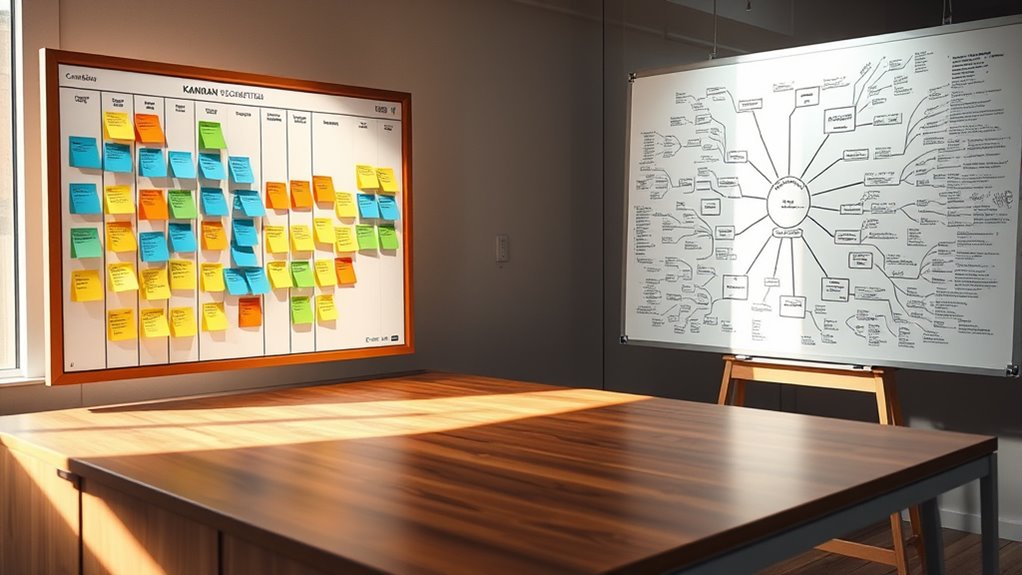To create a personal manifesto in 30 minutes, start by setting a quiet space and gathering paper or a journal. Spend a few minutes brainstorming your core values like honesty, growth, or compassion, being honest with yourself. Reflect on how these values influence your decisions and outline your key life goals. Then, craft a concise statement that combines these elements into an active, inspiring declaration. Keep it flexible, revisit it often, and if you want to explore each step thoroughly, keep going for more insights.
Key Takeaways
- Allocate a dedicated 30-minute session in a quiet space with journal or paper.
- Brainstorm and honestly list your core values, focusing on what truly matters to you.
- Reflect on how these values influence your decisions and goals in life.
- Write a concise, active statement combining your core values and life goals.
- Review and revise your manifesto regularly to stay aligned with your evolving self.

Have you ever wondered what truly guides your actions and decisions? Crafting a personal manifesto is an empowering way to uncover that clarity. It begins with understanding your core values—those fundamental beliefs that shape how you see the world and what you stand for. Your core values act as a compass, steering your choices and behaviors, especially when faced with difficult decisions. When you align your actions with these deeply held principles, life feels more authentic and purposeful. Alongside these values, defining your life goals provides a clear destination. Your goals give you direction, motivation, and a sense of progress. Together, your core values and life goals form the foundation of your personal manifesto, helping you articulate who you are and what you want to achieve.
Start by setting aside a dedicated 30-minute window for this exercise. Find a quiet space where you won’t be interrupted and gather a notebook or journal. Begin by brainstorming your core values—think about what matters most to you: integrity, compassion, growth, independence, or creativity. Write down the ones that resonate most deeply. Be honest with yourself; this isn’t about what others expect but what truly reflects your inner beliefs. Once you’ve identified these core values, reflect on how they influence your daily life and decision-making. Ask yourself: Are my actions aligned with these values? If not, what adjustments can I make? This self-awareness is vital in crafting an authentic manifesto. Incorporating sound design techniques can amplify how you express these principles in your personal narrative.
Next, shift your focus to your life goals. These could be personal, professional, or a blend of both. Think about where you want to be in a year, five years, or even a decade. Be specific—whether it’s advancing in your career, nurturing meaningful relationships, or cultivating a new skill. Write down your top priorities, making sure they reflect your values. For example, if one of your core values is growth, your goals might include learning a new language or pursuing further education. As you jot these down, aim for clarity and realism to keep your goals achievable and motivating.
Now, combine your core values and life goals into a concise statement. This is your personal manifesto—a declaration that captures what you stand for and what you aim to accomplish. Use active language, affirm your commitment, and keep it authentic. Read it aloud, revisit it regularly, and revise as needed. Your personal manifesto isn’t set in stone; it’s a living document that evolves with you. In just half an hour, you’ve created a powerful guide to align your actions with your true self, providing the motivation and clarity to pursue your life with purpose.
Frequently Asked Questions
Can I Update My Manifesto Later?
Yes, you can update your manifesto later. Personal growth and goal setting are ongoing processes, so your manifesto should evolve as you learn and change. Regularly revisiting and refining your statements helps stay aligned with your current aspirations. Don’t hesitate to make adjustments; it’s a sign of growth. Updating your manifesto keeps it relevant and inspiring, guiding you effectively on your journey toward self-improvement and achieving your goals.
Is a Personal Manifesto Legally Binding?
You might wonder if your personal manifesto has legal implications, but it’s not legally binding. It’s a powerful tool for self-reflection, not a contract. While it can emotionally impact your life by guiding your values and decisions, it doesn’t hold legal weight. You can update it anytime, ensuring it evolves with your growth. So, rest assured, your manifesto’s purpose is personal, not legal, giving you freedom and flexibility.
How Often Should I Revisit My Manifesto?
You should revisit your personal manifesto regularly to guarantee it reflects your evolving self through honest self reflection. Aim to review it at least every few months, especially during times of goal adjustment or significant life changes. This habit keeps your intentions clear, motivates growth, and aligns your actions with your core values. Consistent updates help you stay true to yourself and adapt your manifesto as you grow.
Can I Include Specific Goals in My Manifesto?
Yes, you can include specific goals in your personal manifesto. Doing so helps clarify your personal goals and enhances goal specificity, making your intentions clear and actionable. Be sure to frame these goals positively and realistically, aligning them with your core values. Including specific goals in your manifesto keeps you focused and motivated, guiding your daily actions toward achieving what matters most to you.
Do I Need Professional Help to Create One?
Did you know that 70% of people find professional guidance boosts their confidence in creative writing? You don’t need expert help to craft your personal manifesto. It’s a deeply personal process, and your insights matter most. While professional guidance can offer structure, it’s not essential. Trust your instincts, and remember, your unique voice shapes your manifesto—no need for outside help unless you want extra inspiration.
Conclusion
Now that you’ve crafted your personal manifesto, remember it’s your compass—your guiding star. While it grounds you in your values, it also leaves room for growth and change. Like a sturdy ship steering through shifting seas, your manifesto helps you stay true, yet adaptable. Embrace it as a living document—bold enough to declare your purpose, flexible enough to evolve. In a world of constant change, your clarity becomes your anchor, and your authenticity, your compass.








